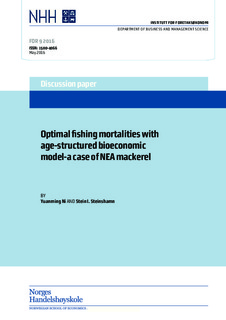Optimal fishing mortalities with age-structured bioeconomic model - a case of NEA mackerel
Working paper

Åpne
Permanent lenke
http://hdl.handle.net/11250/2391730Utgivelsesdato
2016-05-31Metadata
Vis full innførselSamlinger
- Discussion papers (FOR) [566]
Sammendrag
The effects of random environmental impacts on optimal exploitation of a fish population are investigated using both optimization and simulation, based on a discrete-time age-structured bioeconomic model. The optimization problem is solved as a non-linear programming problem in GAMS. First, a basic model structure and 6 different scenarios, dealing with two interactions between fish and environment, are introduced. Based on the simplest scenario, eight different parameter combinations are tested. Then the optimization problem is solved for each of the 6 scenarios for a period of 100 years in order to gain long term insights. The main finding is that higher volatility from the environment leads to higher net profits but together with a lower probability of actually
hitting the mean values. Simulations are conducted with different fixed fishing mortality levels under 6 scenarios. It seems that a constant fishing mortality around 0.06 is optimal. In the end, a comparison is made between historical and optimal harvest for a period of 40 years. It turns out that in more than 70% of the time, the optimal exploitation offered by our optimization model dominates the historical one, leading to 43% higher net profit and 34% lower fishing cost on average.